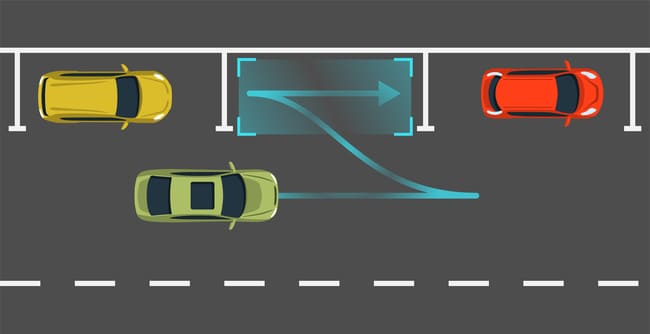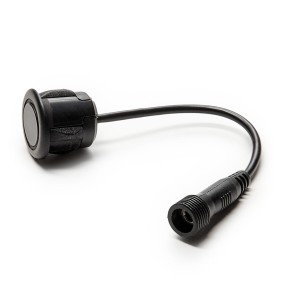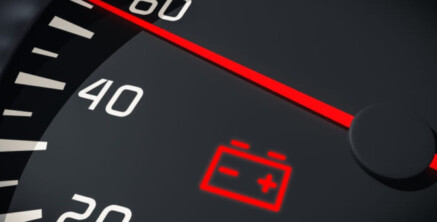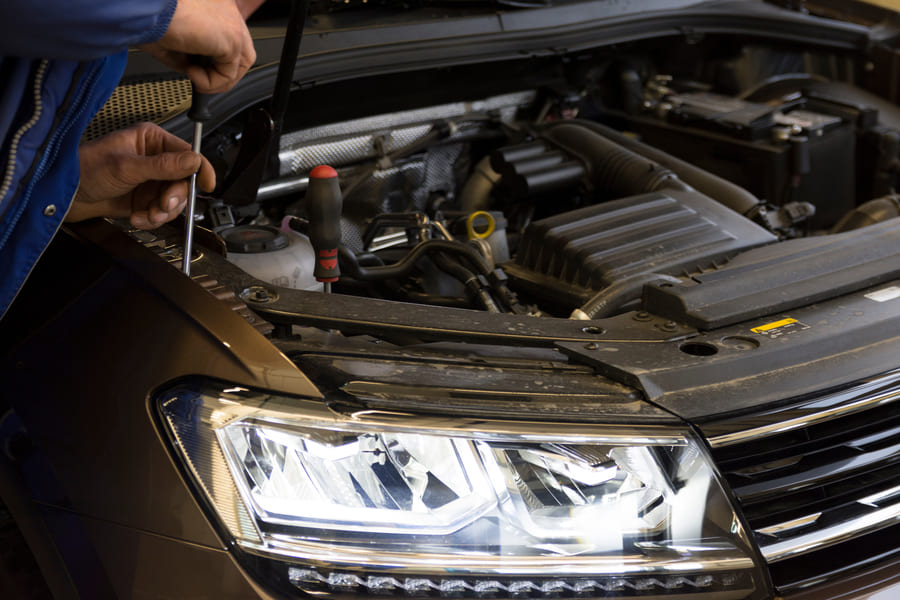
What is the most anxiety inducing aspect of being behind the wheel? Possible traffic collisions? Road rage? Breaking down for no apparent reason? No. Apparently, almost half of 18-34 year old drivers find that parallel parking is their biggest stress. It’s the maneuver that everyone dreads being asked to perform during their driving test and well after people have obtained their driving licence they can struggle with it. Luckily, our guide is here to explain and to give you some tips and hints to help you parallel park, as well as reverse park and forward bay park, perfectly every time.
Forward Bay Parking

We’ll start with an explanation of forward bay parking, what is often considered to be the easiest of these three parking maneuvers. This procedure involves driving the car forwards into an empty parking bay. While it doesn’t sound that difficult, obstacles on either side must be taken into consideration along with distance from the bay, where and when to begin turning in relation to the bay, and the car’s speed. Getting into the bay itself isn’t normally a problem when there is nothing around, but it is a real test of observation to get in and out in a busy car park as there can be many hazards around us.
Here’s some tips to help keep parking fears at bay:- The first step is to make sure that you are a good distance, ideally as far as possible, away from the bay you want to park in. This gives you the widest possible turning radius and more time to turn and to correct your angle, without having to reverse or straighten up when you are in the bay.
- It should go without saying, but before you turn, make sure you use your indicators to signal your intent to other road users. Check your mirrors at this point as well, looking for current or potential hazards.
- Now you are looking out for the first point of reference to help you park – the boundaries of the parking bay you want to park in, often white lines on the ground. When you see the first white line just underneath your right door mirror, you can check one final time in your mirrors and then steer to full lock, (turning the steering wheel as far to the left or right as it will go). An important aspect of this is making sure to take your time and go as slowly as possible; the slower you go, the more time you give the vehicle to turn and the less likely you are to have to make adjustments. Even if it seems like a brilliant idea to swing the car into the spot as fast as possible, it definitely isn’t!
- As you turn into the bay, begin to straighten up your steering once your car is parallel or nearing parallel with the white lines of the bay (you can see these in your mirror) or if you can tell the car is straight using objects visible through the windshield. You can use both wing mirrors to check if the car is straight, apply then handbrake, and then you are done!
Reverse Parking into a Bay

To paraphrase Isaac Newton, what goes into a parking bay, must come out of a parking bay. If you park moving forwards into a bay, you’ll have to reverse out of it. This can be quite tricky or time consuming when there is a lot of traffic or footfall in a car park. What a lot of drivers prefer, therefore, is reverse parking into a bay, to make sure that you can slip away quickly and comfortably when you want to.
Even if you do opt for forward bar parking, it’s definitely worth getting to grips with reverse parking as you’ll be reversing out of your spot anyway. This turn uses the same principles as the forward bay park but, because the car is moving in reverse, it requires just that bit more observation and awareness.
Here are some simple steps to help perfect your reverse bay parking:- Once again, try and get the car a good distance away from the bay you would like to park in (to get a wide turning arc) and make sure your car is in front of the desired bay. If you’re turning into a bay that is on the side of a road, you the middle of the road is a good distance away, but this of course means extra precaution must be taken in checking for and alerting other road users to your intent.You should also be aware that the front of your car will swing out as you reverse into the bay and there is a risk of hitting any objects that are on the opposite side of the bay, such as low walls or fences, so take extra care! If there are any vehicles or cyclists behind you, as well as any close or approaching pedestrians, stop and let them pass.
- Next, slowly reverse your car until you reach the point of turn. This point is slightly different for all cars, so you will need to establish your own way of recognising when you have reached this point. It is roughly when the first white line of the bay is parallel to the middle of your vehicle. As with the forward bay park, you can use your mirrors and glance out of your window to help establish this. When you hit this point, check once more for nearby cars or pedestrians, stopping if necessary, and then turn your steering wheel to full lock in the direction you wish to go.
- Continue to move slowly in reverse, checking both sides and all around you to make sure you aren’t going to collide with any object either behind or to the side of you. You can also be checking for the white lines of the bay and using your rear view mirror to see when you are inside the bay. When your car is parallel to the white lines and straight inside the bay, straighten the wheel up.
- Once your car is straight inside the bay, keep moving very slowly in reverse until the front of the lines marking out the bay are ahead of your car. This might not be possible for some larger or longer vehicles, but for most ordinary cars it is a good indicator that you have reached a point where your car is safely parked within the bay. Your perfect reverse bay park is finished!

Parallel Parking

What is it about the parallel parking that makes people break out in a cold sweat? Why do so many consider it the most stressful aspect of driving? As with the reverse bay park, the car is travelling backwards limiting their ability to see what potential hazards which the car is moving towards and forcing them to be constantly turning their head to look out for any potential hazards.
On top of this, timing has to be perfect when parallel parking: since you are often parking your car behind a vehicle that is already parked (and even sometimes between two already parked cars) the chance of collision increases and the space is a lot smaller or tighter than a predesigned parking bay.
But you need not fear, if you follow these tips on how to parallel park correctly, your parking nightmares will be over:- Find the space you would like to parallel park into. This is often likely to be between two cars or at least behind one car. Drive a good distance (about one car length) in front of the car behind which you wish to park, so you have plenty of time to slowly reverse and consider when and where to begin turning. As you’re about to stop, check your mirrors and around you for other road users.
- Before you start reversing backwards, check for any approaching vehicles or cyclists and wait till they have passed.
- Once you are happy it is all clear, look out of the rear window, then proceed to move the car backwards, taking your time and moving slowly until the rear of your car is level with the rear of the car ahead of the space you wish to park in. It’s important you go far enough back – if you don’t, there is the risk that you will turn into the car next to you.
- Once the rear of your car is level with the rear of the already parked car, you’re at the point of turn and are about to steer into the space. This is the most hazardous part of the manoeuvre as the front end of your car will swing out into the road. Before you do anything else, observe the road once more to make sure there are no cyclists, cars, or pedestrians close to you. Remember to always check your right blind spot too.
- If everything is quiet, move very slowly backwards and as you move the car, steer 1 complete turn (360 degrees) in the direction of the space (e.g. if it’s on your left, turn the wheel left). By turning the wheel only 1 turn instead of full lock, it will make the turning angle slightly shallower at around 45 degrees. This gets rid of the possibility of you backing into the car next to you.
- Now you need to establish when to straighten up the car. Whilst reversing, you will need constant all-round observation and must stop if any vehicles approach. Also if you are reversing towards pedestrians, stop and allow them to pass before proceeding. Don’t forget to check your rearview mirror frequently. The point when you straighten up varies from car to car, but usually lining the left corner of your car up with the right corner of the car you are parking behind works as a good reference point. Once they are lined up, turn the steering wheel in the opposite direction, this time to full lock. You can even stop at this point to give yourself more time to check around you for hazards or to turn the wheel.
- Turning your steering wheel to full lock will bring the car parallel to the kerb. As you’re moving backwards, keep checking your wing mirror that you are not going to hit the kerb or that you are too far away from it; leaving your car too far out from the kerb can be incredibly dangerous. If you are too far out, you’ll need to pull back out slightly and then reverse again, this time turning more in the desired direction so you get closer to the kerb.
- Once you are close enough to the kerb and have begun to straighten up your car, continue to move slowly until the car is completely parallel to the kerb, using your wing mirror to judge this. It’s always best to make sure that your car isn’t too close to the car in front, to give them space to reverse slightly and help them move off. A gap of about a quarter of a car length or 1m can be a godsend to drivers when they need to maneuver out of a tight space.
Parking Aids: Reverse parking with cameras and sensors

Parking in reverse should now be simple thanks to the top tips and hints we’ve given you, but if it’s all still a bit daunting there are now tons of gadgets that come either as standard or can be integrated with your car to aid you when reverse bay and parallel park. The most useful of these are either reversing or parking sensors or cameras.
Parking sensors are proximity sensors designed to let drivers know when there are obstacles, either moving or stationary, in the way when parking. These systems use either electromagnetic or ultrasonic sensors. Ultrasonic systems use sensors located on the front or rear bumper to detect objects, whereas electromagnetic systems often come equipped with cameras and do not require any extra holes to be drilled in you car (like ultrasonic sensors) as they can be mounted discreetly on the inner side of the cars bumper. When ultrasonic sensors were first developed in the 1970s, they were rejected by Jaguar as being unnecessary and likely to be unpopular. Times have definitely changed; now they often can come as standard from the manufacturer.
Both systems often use noises to alert drivers when there is an obstacle behind them and make it easier to work out if your car is about to hit the kerb or another car when parallel or reverse parking.
In addition to sensors, there’s also a wide range of parking cameras available. These are cameras which attach to the back of your car and are linked to a screen which can be positioned on your dashboard. They give the driver an image of what is directly behind their car and often come with software which shows you the ‘parking line’ (the potential position of your vehicle if you continue to move in that trajectory). This can be extremely helpful when lining your car up within a parking bay or in a parallel parking space. A handful of cameras even come with night vision settings and variable angle settings, so you can adjust how much you see behind you. Lots of these cameras are relatively inexpensive and all are user friendly and easy to use. Some of the best parking cameras come from Pioneer, Vordon, or Valeo and for reliable parking sensors a wide range come from Amio, Stark, and Ridex.
With all of this guidance and some of this fantastic technology, you should be able to reverse, bay, and parallel park perfectly.


















Comment